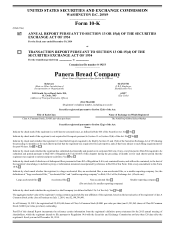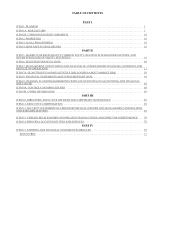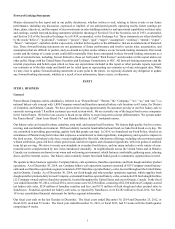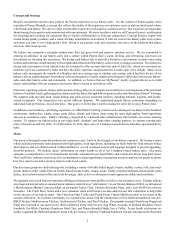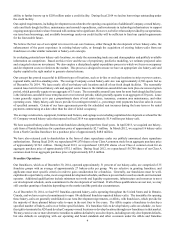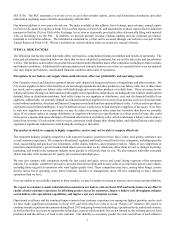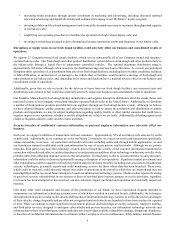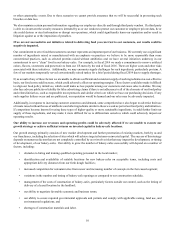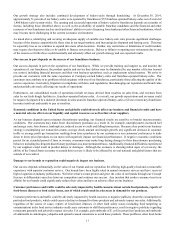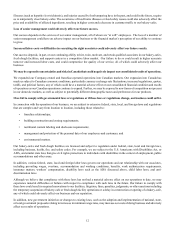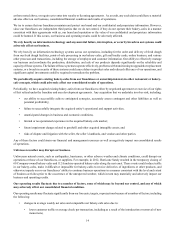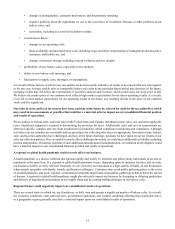Panera Bread 2014 Annual Report Download - page 19
Download and view the complete annual report
Please find page 19 of the 2014 Panera Bread annual report below. You can navigate through the pages in the report by either clicking on the pages listed below, or by using the keyword search tool below to find specific information within the annual report.7
SEC-0330. The SEC maintains a web site (www.sec.gov) that contains reports, proxy and information statements, and other
information regarding issuers that file electronically with the SEC.
Our Internet address is www.panerabread.com. We make available at this address, free of charge, press releases, annual reports
on Form 10-K, quarterly reports on Form 10-Q, current reports on Form 8-K, and amendments to those reports filed or furnished
pursuant to Section 13(a) or 15(d) of the Exchange Act as soon as reasonably practicable after electronically filing such material
with, or furnishing it to, the SEC. In addition, we provide periodic investor relations updates and our corporate governance
materials at our Internet address. The information contained on, or that can be accessed through, our website is not part of this
Annual Report on Form 10-K. We have included our website address solely as an inactive textual reference.
ITEM 1A. RISK FACTORS
The following risk factors could materially affect our business, consolidated financial condition and results of operations. The
risks and uncertainties described below are those that we have identified as material, but are not the only risks and uncertainties
we face. Our business is also subject to general risks and uncertainties that affect many other companies, including overall economic
and industry conditions. Additional risks and uncertainties not currently known to us or that we currently believe are not material
also may impair our business, consolidated financial condition and results of operations.
Disruptions in our bakery-cafe supply chain could adversely affect our profitability and operating results.
Our Company-owned and franchise-operated bakery-cafes depend on frequent deliveries of ingredients and other products. We
rely on one supplier to deliver the majority of our non-dough ingredients and other products to our bakery-cafes two or three times
per week, and we supply our bakery-cafes with fresh dough and certain other products on a daily basis. There are many factors
which could cause shortages or interruptions in the supply of our ingredients and products, including adverse weather, unanticipated
demand, labor or distribution problems, food safety issues by our suppliers or distributors, cost, and the financial health of our
suppliers. Additionally, we currently depend on a limited number of suppliers for several of our proteins, such as selected proteins
raised without antibiotics, which are sold in most Company-owned and franchise-operated bakery-cafes. As there are few producers
of proteins raised without antibiotics, it may be difficult or more costly for us to find alternative suppliers, if necessary. If we have
to seek new suppliers or service providers, we may be subject to pricing or other terms less favorable than those we currently
enjoy. If we cannot replace or engage distributors or suppliers who meet our specifications in a short period of time, this could
increase our expenses and cause shortages of food and other items at our bakery-cafes, which could cause a bakery-cafe to remove
items from its menu. If such actions were to occur, customers could change their dining habits, and affected bakery-cafes could
experience significant reductions in sales during the shortage or thereafter.
The market in which we compete is highly competitive, and we may not be able to compete effectively.
The restaurant industry is highly competitive with respect to location, customer service, price, value, food quality, ambiance, and
overall customer experience. We compete with national, regional, and locally owned food service companies, including specialty
food, casual dining and quick-service restaurants, coffee chains, bakeries, and restaurant retailers. Many of our competitors or
potential competitors have greater financial and other resources than we do, which may allow them to react to changes in pricing,
marketing, and trends in the restaurant industry more quickly or effectively than we can. We also compete with other restaurant
chains and other retail businesses for quality site locations and employees.
We may also compete with companies outside the fast casual and quick service and casual dining segments of the restaurant
industry. For example, competitive pressures can come from deli sections and in-store cafés of several major grocery store chains,
including those targeted at customers who want higher-quality food. These competitors may have, among other things, a more
diverse menu, lower operating costs, better locations, facilities or management, more effective marketing or more efficient
operations than we have.
If we are unable to successfully compete in these markets, we may be unable to sustain or increase our revenues and profitability.
We expect to continue to make substantial investments in our bakery-cafes in fiscal 2015 and in the future in an effort to
enable a better customer experience by affording greater access for customers, improve bakery-cafe throughput, enhance
our in-bakery-cafe operational capabilities, and improve our core enterprise systems.
Operational excellence and the continued improvement of our customer experience are among our highest priorities and as such
we have made significant investments in fiscal 2013 and 2014 which we refer to as our “Panera 2.0” initiative. We expect to
continue to make significant investments during fiscal 2015 and going forward in technology, operational tools, and related systems,
as well as the labor necessary to support this technology, in areas which include, but are not limited to, the ordering process, food
production and the delivery of food to the customer. Our inability to accurately predict the costs and rollout of such initiative


